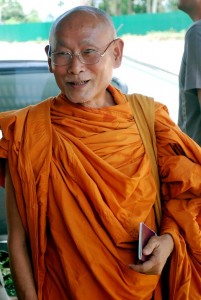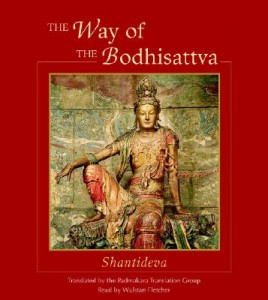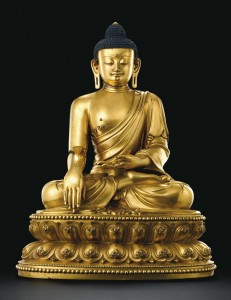History, tradition, and legend have it Siddhartha Gautama, Shakyamuni, the Buddha, achieved enlightenment at about the age of 35 during the course of one night after renouncing the life of severe and life threatening austerity which he had followed for six years. This grand moment of cognition happened somewhere around 450 BCE in what is now northern India and was accompanied by feelings of happiness, confidence, concentration, and equanimity. From it has grown the immense belief system called Buddhism.
At that time the Buddha said he recollected his manifold past lives–one birth, two births, three births, and so on up a hundred thousand births; there he was so named . . . such was his experience of pleasure and pain, such was his lifespan; and passing away from there he was reborn elsewhere; and there too he was so named . . . . The orthodox and the faithful believe this literally; a modernist might interpret this in psychological terms as being able to go back in memory to all the events of one’s infancy, childhood, adolescence, young adulthood, middle age, and so on–to all our own developmental lifespans, and view it as an exploration of the unconscious and the forgotten leading to a life marked by an understanding of causes rather than one driven by unconscious, semi-conscious, and mysterious forces.
Next he understood how beings fare according to their actions stretching back into the timeless past. This amounted to a verification of the principle of karma and led to the complex concept of causality known as dependent origination. We are rewarded and suffer by the results of our actions, not how they stack up against commandments. The orthodox and the faithful think here of  auspicious or painful rebirth; a modernist would take a shorter view and think once more of gaining a large understanding of causality and contextuality in one’s personal life–that is understanding and accepting how one got to where one is by one’s actions–for better or worse–at this very moment.
auspicious or painful rebirth; a modernist would take a shorter view and think once more of gaining a large understanding of causality and contextuality in one’s personal life–that is understanding and accepting how one got to where one is by one’s actions–for better or worse–at this very moment.
Finally, the Buddha achieved knowledge of the destruction of defilements–a new, original discovery that emerged from the familiar and traditional doctrines of rebirth and karma. His recollection of earlier lives destroyed the past as a source of identity and replaced it with the happy experience of release from all that. In the eternal present he saw that human identity is an illusion–the cause of suffering and the key to its remission. In the chain of dependent origination there is no person, no agent, no self. He reworked the human condition dramatized by the memory of past lives into the core of early Buddhist dharma–the four noble truths. Siddharta awakened.
He then asked himself if he should undertake the wearying and troublesome task of teaching what he had just learned to others who might not understand or should he remain alone enjoying this new state of mind–concentrated, bright, malleable, steady, pure. In the early Buddhist tradition it is here the Brahma Sahampati appears to him and says,
Arise, victorious hero, caravan leader,
Debtless one, and wander the world.
Let the Blessed One teach the Dhamma,
There will be those who will understand.
When Sahampati realizes the Buddha has consented to his request to instruct others, he departs; the experience of enlightenment has been completed by the promise of practice and activity for others.
Throughout the long course of Buddhist thought and practice after this, two role models dominated the landscape—the Arhat and the Bodhisattva. For the early Buddhists, the consummation of a human lifetime derived from a withdrawn, often monastic, existence marked by poverty, chastity, and obedience. The successful monk or nun who realized nirvana became an Arhat. For the later Mahayana Buddhists the ideal life evolved into one marked by heroic involvement in the world, an engaged life infused with wisdom and compassion—the latter often spoken of as highly skillful teaching of the Mahayana way. The man or woman achieving this enlightenment became a Bodhisattva and potentially a veritable Buddha.
But what is Enlightenment? What is this idea that causes many to look longingly in the direction of Buddhism?
 In the Mahayana tradition, one answer to the question is sunyata (emptiness), open space in a paragraph implying an answer that cannot be put into words, an answer which clears the ground and prepares the way for a second answer.
In the Mahayana tradition, one answer to the question is sunyata (emptiness), open space in a paragraph implying an answer that cannot be put into words, an answer which clears the ground and prepares the way for a second answer.
It is Bodhicitta (awakened mind), the crucial, momentary experience of which awakens one to the possibility of becoming an enlightened being and motivates one to undertake the arduous journey to that end. Shantideva, the great 8th century Indian monk, poet, and scholar likens the experience to seeing a flash of lightning that rends the night, and in its glare shows all that the dark clouds hid; like lightning, he says, good and virtuous thoughts are brief and transient, but bodhicitta, like a hero, protects them. It is a state of mind, an invaluable attitude, a jewel of the understanding that inspires a promise, a vow to advance step by step to help others. This is the original vow.
William James, the American psychologist and philosopher, describes a similar state of mind and experience which causes “a self hitherto divided, and consciously wrong, inferior, and unhappy” to experience a turning around or tipping over of these negative qualities. There is great happiness, a sense of wellness and health. Mysteries are cleared up, replaced by a sense of truth beyond words. The world is fresh and new. Equanimity replaces anxieties and there is an opening up of new reaches of fortitude and patience. Motives to antipathy are reduced; there is a shifting of emotional center, an increase of tenderness and charity for fellow creatures. This alteration of attitude carries charity with it, resulting in a feeling of jubilation, an expansive condition engendering self-forgetful and kindly sentiments.
Perfected enlightenment is implicit in that moment, but is only fully realized after a long period of cultivation leading to a state where one’s actions enact an understanding of dana (generosity), sila (morality), ksanti (patience), virya (effort), samadhi (meditative calm and insight), and prajna (wisdom). The point where knowledge and behavior are integrated is the consummation, the point where doing the right thing becomes effortless and rewarding. This condition is the perfection of the original vow.
Shantideva once more:
For all those ailing in the world
Until their every sickness has been healed,
May I myself become for them
The doctor, nurse, the medicine itself.
Raining down a flood of food and drink
May I become a treasure ever plentiful,
And in the ages marked by scarcity and want,
May I myself appear as drink and sustenance.
For sentient beings, poor and destitute,
May I become a treasure ever plentiful,
And lie before them closely in their reach,
A varied source of all that they might need.
– – – – – – – – – – – – – – – – – – – –
This essay is Richard Mercer’s second analysis of heroism from the Buddhist perspective. His first essay focused on the Bodhisattva. Mercer has been a Visiting Instructor of English and Core (especially Edgar Allan Poe and Samuel Beckett) at the University of Richmond. He has studied Buddhism since the early 1990s. Only recently has he realized that the Bodhisattva ideal is a wonderful and practicable model to follow.
